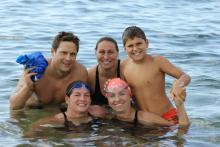Paralympic Movement About More Than Games
The IPC’s Stuart Lieberman explains how the everyday moments in athletes’ lives are what make the Paralympic Movement so unique. 20 Apr 2012 By IPCIt’s about changing perceptions, breaking barriers and doing what you were once told you would never be able to do. It’s literally about people on the move; people who reshape our world in the everyday aspects of life.
The Olympic Movement fits cozily into a box.
Stick with me here, I’ll get to the Paralympics in a minute.
Back to the box now, where the Olympic Movement has defined boundaries and is fully geared toward the elite-level competition every two years.
With this week marking 100 days out until the largest Paralympic test event, as many have coined it, I’ve thought a lot about what makes the Paralympics different from the Olympics.
I’m not so certain the two are exactly parallel, as the connotation infers.
To me, the word “Olympic” definitely carries the most weight in the phrase “Olympic Movement.”
But when it comes to the Paralympic Movement, it’s definitely the latter term that is the driving force.
In the Olympic Movement, the most exhilarating moments usually come when an athlete wins gold.
In the Paralympic Movement, those moments can come on any typical day.
The Paralympic Movement is about so much more than just the Paralympic Games.
It’s about changing perceptions, breaking barriers and doing what you were once told you would never be able to do.
It’s literally about people on the move; people who reshape our world in the everyday aspects of life.
Yes, the Paralympic Games showcase athletes competing at the highest level in their sports, but I think what the public does not see enough of are the little moments in athletes’ lives when they inspire those at the grassroots level or open the eyes of someone who has never seen a para-athlete before.
Take 21-year-old Scott Reardon.
While Scott recently won the 200m sprint at the Australian Athletics Championships last weekend, what amazes me the most is what he did behind a boat the last several years.
In 2002, a tractor severed Scott’s right leg through the knee when his shoelace got caught, but that didn’t end his love for waterskiing, as he went on to win the world title in the sport in 2007 and 2009 on just one leg.
And believe me, that’s no easy feat. The two times I water skiied –on two legs albeit – I fell face first into the water.
Then there’s Canadian Michelle Stilwell, a two-time Paralympic gold medallist in wheelchair racing.
Yet again, it’s the little things she does to help propel the Movement.
Last month, Michelle took part in the Malabar Beach 1km Open Water Swim in Australia. The race raised funds for Rainbow Club Australia, a non-profit charity that provides funds for swimming and recreational activities for young people with disabilities.
What brought the foundation of the Movement closest to home for me was when I had the chance to climb a mountain with American swimmer Rudy Garcia-Tolson in Colorado a few summers ago. I sweat it out like none other trying to keep up with the double-leg amputee en route to the peak.
And to think there’s 4,197 other people like Scott, Michelle and Rudy that have the chance to compete in London this summer, well, that’s just mind-blowing.
Furthermore, according to the United Nations, around 10 per cent of the world’s population – or 650 million people – live with a disability, making it the world’s largest minority.
This Movement has the potential to make the largest minority part of the majority, and there’s so many other summer and winter athletes out there providing their own daily contributions to help push it forward.
Esther Vergeer, Thomas Jacobsen, Anjali Forber-Pratt, Andre Brasil, Dror Cohen and Patrick Anderson to name a few.
So act now to educate yourself and find out how they’re impacting the world on a day-to-day basis. Because by the time they reach the international podium you may have missed out on some of the best stories.
So go ahead. Google them. You won’t regret it.
They’re the ones keeping the Paralympics on the move.
Stuart Lieberman
IPC Editorial and Social Media Co-ordinator








